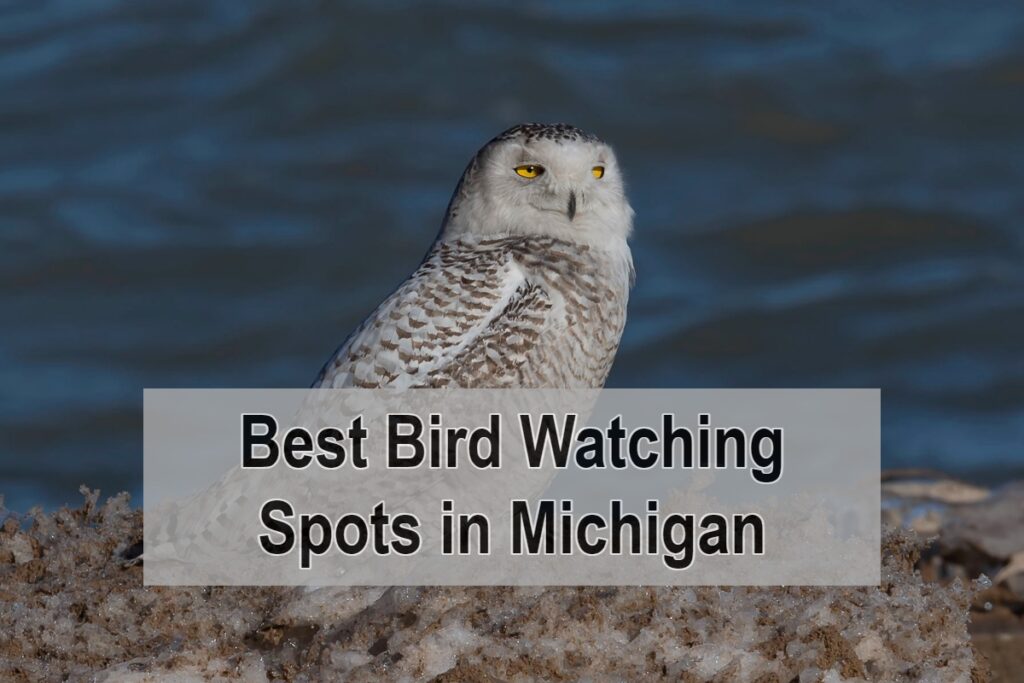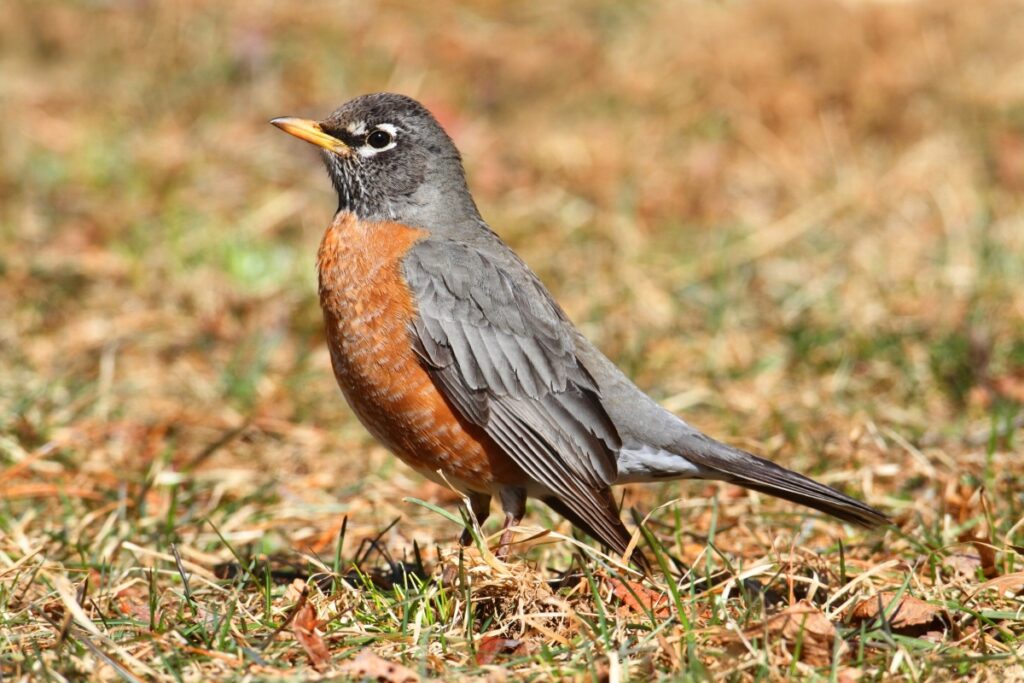As an Amazon Associate, we earn from qualifying purchases with no additional costs for you.
Michigan is one of the states in the Great Lakes region of the country. This state is rich in birdlife, with more than 450 species recorded. The problem is knowing which the best places are for bird watching. This is why I compiled this list of best spots for bird watching.
The best bird watching spots in Michigan border the Great Lakes. Such areas include Whitefish Point and Point Mouillee. The marshes at Arcadia provide a unique habitat for birds. For unusual southern birds, you can visit Tawas Point, a good spot for migrant species.
A table giving the most exciting birds you can see at each of my top 10 birding spots in Michigan:
| PARK | INTERESTING BIRDS YOU CAN SEE |
|---|---|
| Whitefish Point Bird Observatory | Northern Saw-whet Owl and Boreal Chickadee |
| Seney National Wildlife Refuge | Common Loon and Trumpeter Swan |
| Point Mouillee State Game Area | Whimbrel and Osprey |
| Shiawassee National Wildlife Refuge | Sandhill Crane and Long-eared Owl |
| Warren Dunes State Park | Summer Tanager and White-eyed Vireo |
| Huron-Manistee National Forest | Kirtland’s Warbler and Tundra Swan |
| Tawas Point State Park | Prothonotary Warbler and Scissor-tailed Flycatcher |
| Nayanquing Point State Wildlife Area | Lesser Scaup and Ring-necked Duck |
| Belle Isle Park | Hooded Merganser and Canvasback |
| Arcadia Marsh Nature Preserve | American Black Duck and Merlin |
Read on below to discover more information and details on what the best bird watching places are in the state of Michigan. I also describe which bird species you will most likely find in the top bird watching spots.
TIP: If you want to check out the best pair of binoculars for bird watching, we recommend a pair of waterproof and fog-proof 8 x 42 binoculars like the Celestron – Outland X 8×42 Binoculars (Amazon link).
Best Places to Bird Watch in Michigan
Michigan is one of the largest eastern states in the U.S. and boasts a 3000-mile coastline that follows the shores of three Great Lakes.
1. Whitefish Point Bird Observatory
This piece of land occurs on the northern shore of the Upper Peninsula Region of Michigan—the land projects into Lake Superior. At least 340 bird species have been recorded in this area.
Whitefish Point Bird Observatory is an excellent place to view migrating ducks, geese, shorebirds, and raptors. Common Loons, Bonaparte’s Gulls, and Sandhill Cranes are in the area.
Owls recorded here include the Northern Saw-whet Owl, Boreal Owl, and Long-eared Owl.
The wooded dunes of this area make an excellent spot for migrating birds. The site is a good birding hot spot. Nesting birds to look out for in the reserve include Boreal Chickadees, Black-backed Woodpeckers, Hermit Thrushes, Red Crossbills, Purple Finches, and Pine Siskins.
2. Seney National Wildlife Refuge
This refuge is 90,000 acres in size. This area is perfect for birds because of the wide diversity of habitats. Habitats in the refuge include wetlands, bogs, forests, and marshlands.
The winters in the refuge are freezing, and the visitor center is only open from May to October. You should keep this in mind when planning a visit to Seney.
There is a drive you can take and a few observation decks providing good spots to search for birds from. Birds you can find in the refuge include Common Loons, Trumpeter Swans, Hooded Mergansers, and Ring-billed Ducks. Check marsh vegetation for the Marsh Wren and Sedge Wren.
The forested and dense woodland areas may yield yellow-bellied flycatchers and Black-billed Cuckoos.
Watching for Bald Eagles and Osprey over and near the water would be best. Some unique birds are difficult to see; these include the following species: Northern Saw-whet Owl, Spruce Grouse, and Yellow Rail. You can access a complete bird species checklist for the refuge.
TIP: Knowing how to spot the birds in your yard is key to enjoying visits from your winged friends as much as possible! The best sources are trusted books, I recommend using the following (Amazon links):
– National Geographic Field Guide to the Birds of North America
– National Audubon Society Birds of North America
3. Pointe Mouillee State Game Area
This area is approximately 20 miles south of Detroit and on the western side of Lake Erie. At least 280 species of birds have been recorded here in the game area. At least 4,000 wetlands are present, attracting large waterfowl and shorebirds.
You can look for birds in the open water, the marshes, and the muddy areas on the pond edges. Birds in the marsh spots include American Bitterns, Sora, and Least Bitterns. You can check the wetlands for Common Gallinules and an assortment of ducks and geese.
Species near the wetlands include the American White Pelican, Snowy Egret, and Black-crowned Night-Heron. You can also find the following species in this state game area: Glossy Ibis, Bald Eagle, Whimbrels, and Osprey.
4. Shiawassee National Wildlife Refuge
Close to 300 species of birds have been recorded from taking a drive around the refuge. Shiawassee National Wildlife Refuge is 10,000 acres in size. The habitats include impoundments, grasses, marshes, and bottomland hardwood forests.
You can find species such as Long-eared Owls and Rough-legged Hawks here. Sandhill Cranes occur in winter in flocks.
Other birds to look out for in the refuge include Lapland Longspurs, Northern Shrikes, and Short-eared Owls. Common Redpolls and Snow Buntings can also be seen in the refuge.
5. Warren Dunes State Park
This state park is on the edge of Lake Michigan; as the name implies, it has dunes. The dunes are high at about 240 feet. The area is suitable for migrating songbirds when many arrive in May. There is a bird species checklist for the park.
At least 257 bird species have been noted in the area. Among waterfowl, you can find the following bird species: Ruddy Duck, Northern Shoveler, Greater Scaup, Blue-winged Teal, Hooded Merganser, Common Goldeneye, Black Scoter, and Wood Duck.
Some birds nesting in the park include Red-headed Woodpeckers, Veerys, and Pine Warblers.
In the big trees, you should watch for the Pileated Woodpeckers who reside here. Species not found in most of Michigan but that are located here include the following: Summer Tanager, White-eyed Vireo, Acadian Flycatcher, and Hooded Warbler.
6. Huron-Manistee National Forest
More than 400 species of birds have been recorded in this area, but the main reason for visiting the forest is to see the rare Kirtland’s Warbler. There is a self-guided tour you can go on to look for this bird. Besides this warbler, several other species have been seen in the forest, including Blackpoll Warblers and Cerulean Warblers.
Observation decks give you views over Lake Michigan, which helps you look for waterfowl and other birds near the water. You can see Trumpeter Swans, Tundra Swans, Ring-necked Ducks, and Buffleheads in the area.
Other species to look out for in the area include the endangered Whooping Crane, Sandhill Crane, and both species of Bitterns.
Buff-breasted Sandpipers and Semipalmated Sandpipers, both vulnerable species, have also been recorded on the shores. These sandpipers can be found feeding in the muddy waters on the lake’s edges.
There is a species checklist for the birds that you can refer to and use when you visit the forest.
7. Tawas Point State Park
This park is on the peninsula of Lake Huron and is 183 acres in size. This is a good area in May to see a lot of migrating birds. You should walk on the Sandy Hook Nature Trail and watch for birds.
Along this trail, many flycatchers, warblers, thrushes, and vireos can be seen. The park has muddy and sandy areas on the lake shore, which is a benefit because it attracts a variety of shorebirds.
You can find bird species, such as Piping Plovers, that breed here, and various gulls and terns like Forster’s Tern. Piping Plovers are of great conservation concern, so this park is an important nesting location for this species.
Rare birds in Michigan that can be spotted in the state park include the Scissor-tailed Flycatcher, Say’s Phoebe, and Prothonotary Warbler.
TOP TIP: Bird watchers are often called funny and interesting names like “Twitchers” or “Bird nerds.” Find out which type you are in this article. This article explains why bird watchers are not weird!
8. Nayanquing Point State Wildlife Area
Nayanquing Point State Wildlife Area is on the western side of Saginaw Bay. Fall and spring are good times to see waterfowl in this area.
Some of the species recorded here in the past include the following: Tundra Swan, Greater Scaup, Lesser Scaup, Ring-necked Duck, American Wigeon, and Pied-billed Grebe.
You can also see birds like Soras, American Bitterns, and Virginia Rails. Besides these three species in the marshy areas, you will also see Marsh Wrens, Yellow-headed Blackbirds, and Swamp Sparrows.
An observation tower is located along East Kitchen Road, which helps check the marshes and look for birds like the rails, wrens, and soras.
9. Belle Isle Park
This is a 985-acre park situated right in the center of the Detroit River. This park is rich in bird species with waterfowl like the Common Merganser, Hooded Merganser, Canvasback, Common Goldeneye, Redhead, and Greater Scaup, as seen from here.
Rare bird species like King Eider and Brant have been seen in the waters here before, so it is worth a visit. Many birders find fall and spring trips productive because migrating birds can be spotted at those times.
These are also the best times to see visiting warblers, flycatchers, and vireos at Belle Isle Park. February is the optimal time to find Bald Eagles in this park.
10. Arcadia Marsh Nature Preserve
This preserve is 273 acres in size and is located close to the town of Arcadia. The area is known to be very good for birds and is, thus, included as one of my top spots.
Arcadia Marsh Nature Preserve allows you to explore a coastal marsh of the Great Lakes and see the birdlife associated with this unique habitat. Many of these habitats are disappearing, which means such preserves are essential for bird conservation.
Bird species in the wetlands include American Black Duck, Common Merganser, Wood Duck, Goldeneye, and Blue-winged Teal. You can also find Green Herons, Common Yellowthroats, and Marsh Wrens. Merlins have been recorded, as have Northern Harriers.
Reclusive marsh birds like the Least and American Bitterns, Sora, and Virginia Rail can also be spotted. You can access a handbook for the birds and other wildlife of the area.
Small passerines that you should look out for in the marshland include such birds as Sedge Wrens, Swamp Sparrows, and Marsh Wrens. Learning the calls of these species is also helpful when searching for them in dense vegetation.
TIP: Check out my recommended products if you are looking for the best and trusted equipment for birdwatching in the wild or on your backyard (Amazon link):
- Celestron Outland X 8×42 Binoculars
- Celestron Ultima 80 Angled Spotting Scope
- National Audubon Society Birds of North America Book
- Design Free-standing Bird Bath
- Smart Bird Feeder with Camera
- Cedar Bird House for Outside
Best Time to Bird Watch in Michigan
Michigan has a long bird list, so you can always see birds no matter the time of year. However, there are certain times of the year when it is best to see particular migrating birds. Many of these birds occur in spring and fall along the shores of the Great Lakes.
| TYPES OF BIRDS | SEASON |
|---|---|
| Sandhill Crane and Bald Eagle | Winter |
| Songbirds such as warblers | Spring, with the highest numbers in May |
The Michigan State Bird
The American Robin, Turdus migratorius, is the state bird of Michigan. The robin is a medium-sized bird easily recognizable and often spotted in gardens.
The bird has a brown back and head, a white eye ring, a yellow beak, an orange underbelly, and a chest. The underside of the tail is white, and the legs are dark.
The bird is widespread in the United States and can be found in grasslands, parks, and gardens. It is quite a bold species that is easy to see. It spends much of its time on the ground searching for insects and worms to eat.
Bird Watching Laws in Michigan
It is illegal for anyone to hunt or have any wild animal or its young, including wild birds like songbirds. All non-game birds are protected except for Feral Pigeons, Starlings, and House Sparrows.
My Favourite Equipment for Bird Watching
Bird watching is one of the least expensive hobbies out there, but you still need some equipment to get the most out of it.
The essential equipment to start bird watching is a pair of binoculars. My preference is 8 X 42 binoculars. The number 8 is how much the magnification is, while 42 is the field of view in millimeters of the lenses.
A pair of waterproof and fog-proof 8 x 42 binoculars like the Celestron – Outland X 8×42 Binoculars on Amazon is an excellent choice for both beginners and experts.
In time, you can choose more expensive models and also opt to buy a spotting scope like the Celestron Ultima 80 on Amazon.
These are a lot more expensive compared with binoculars though, so if you are only a beginner, start with binoculars first. A spotting scope is only helpful for birds far away, such as out on a pond or seashore.
There are a few rules or guidelines you should abide by as an ethical birder. These are listed below.
- Do not enter private lands without prior permission from landowners.
- Follow all the rules in refuges and reserves, including cleaning up any garbage from your campsite.
- Do not disturb birds on nests.
- Do not use apps and play songs to call up birds when they are hungry, tired, and breeding during spring and summer.
Conclusion
Michigan is an excellent state to include on your list of the best bird watching places because it has a long shoreline with the Great Lakes.
This means you can find many waterfowl and migrating birds that follow the shore and stop off along the way.
TIP: If you want to check out the best pair of binoculars for bird watching, we recommend a pair of waterproof and fog-proof 8 x 42 binoculars like the Celestron – Outland X 8×42 Binoculars (Amazon link).


